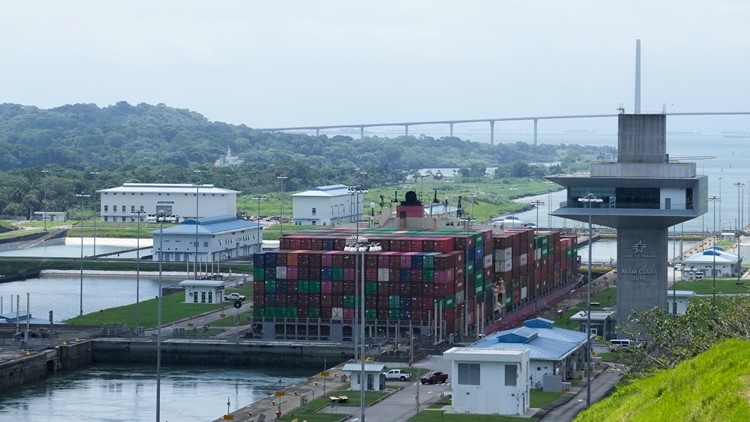
Context
The Panama Canal, a critical artery for global trade, is increasingly vulnerable to the impacts of climate change. As one of the most significant engineering feats of the 20th century, the canal connects the Atlantic and Pacific Oceans, facilitating approximately 5% of international maritime trade. However, changing weather patterns, prolonged droughts, and rising sea levels threaten its operational capacity and, by extension, the global economy.
Overview of the Panama Canal
- The Panama Canal spans approximately 50 miles (80 kilometers) and consists of a series of locks that raise and lower ships between the oceans.
- The canal relies heavily on freshwater from artificial lakes—primarily Gatun Lake and Alhajuela Lake—to operate its locks.
- Each transit of a vessel requires a substantial amount of water, approximately 55 million gallons (250 million liters), released into the sea after use.
- The canal’s design and operation are intricately linked to the region’s hydrology, making it particularly susceptible to changes in rainfall and water availability.
The Impact of Climate Change on Water Supply
- Drought and Water Scarcity: In recent years, Panama has experienced significant fluctuations in rainfall, exacerbated by climate change.
- The year 2023 marked one of the driest periods in the canal’s history, with rainfall levels dropping by 30% compared to historical averages.
- This severe drought has led to a dramatic reduction in water levels in Gatun Lake, which is essential for the canal’s operation.
- Historically, water levels in Gatun Lake hover around 88 feet during the rainy season; however, levels fell to as low as 80 feet in 2023, forcing the Panama Canal Authority (ACP) to impose restrictions on ship drafts and reduce the number of vessels allowed to transit daily.
- El Niño and Climate Variability: The El Niño phenomenon, which typically occurs every two to seven years, has intensified in recent decades, leading to more frequent and severe weather anomalies.
- El Niño events can result in prolonged dry spells followed by heavy rainfall, creating a volatile water supply situation.
- For instance, the 2019 El Niño event was one of the driest years in 70 years, significantly impacting the canal’s operations.
- As climate change continues to alter weather patterns, the predictability of these events diminishes, posing further risks to the canal’s water supply.
Operational Challenges and Economic Implications
- Reduced Capacity and Increased Costs: The ACP’s response to declining water levels has included reducing the number of ships that can transit the canal. In 2023, the number of vessels allowed to pass dropped from an average of 36-38 to as low as 22 per day.
- This reduction has led to significant economic losses, with estimates suggesting a revenue shortfall of between $500 million and $700 million due to restrictions. The implications extend beyond the canal itself, as shipping delays and increased costs ripple through global supply chains.
- Global Trade Disruptions: The Panama Canal is a vital component of the global logistics network, handling approximately 40% of U.S. container traffic and facilitating the movement of goods across continents. Disruptions in the canal’s operations can lead to increased shipping costs, delayed deliveries, and a domino effect impacting various industries, from manufacturing to retail.
- For instance, automotive manufacturers in the U.S. have reported supply chain challenges directly linked to the canal’s operational restrictions, highlighting the interconnectedness of global trade.
Environmental Concerns and Future Risks
- Rising Sea Levels: In addition to drought and changing precipitation patterns, rising sea levels pose a significant threat to the Panama Canal.
- As global temperatures increase, polar ice melts and ocean waters expand, leading to higher sea levels that can impact coastal infrastructure.
- The canal’s locks and surrounding areas may face increased flooding and erosion, further complicating its operational viability.
- Ecosystem Disruption: The environmental impact of climate change extends beyond the canal’s immediate functionality.
- The freshwater ecosystems that support the canal’s operations are also at risk. Changes in water quality, temperature, and flow can disrupt local biodiversity, affecting fish populations and other wildlife that depend on these habitats.
- The degradation of these ecosystems can have long-term consequences for the region’s environmental health and economic sustainability.
Mitigation and Adaptation Strategies
- Water Management Solutions: To address the challenges posed by climate change, the Panama Canal Authority is exploring various water management strategies.
- These include deepening existing artificial lakes to capture more rainwater and investigating alternative water sources.
- One proposal involves constructing a dam on the Indio River to increase water storage capacity, although this plan raises concerns about potential displacement of local communities and environmental impacts.
- Desalination and Alternative Water Sources: Another potential solution is the desalination of seawater to supplement freshwater supplies.
- This approach could help alleviate pressure on the canal’s water sources while ensuring a stable supply for both canal operations and the drinking water needs of Panama’s growing population.
- However, desalination comes with its own set of challenges, including high energy consumption and environmental concerns related to brine disposal.
Conclusion
The Panama Canal stands at a critical juncture as climate change continues to pose an existential threat to its operations and the global economy. With declining water levels, increased operational restrictions, and the potential for severe disruptions to international trade, the urgency for adaptive and sustainable solutions has never been greater. As the world grapples with the impacts of climate change, the fate of the Panama Canal serves as a stark reminder of the interconnectedness of our global systems and the need for collective action to safeguard vital infrastructure. Addressing these challenges will require innovative approaches, international cooperation, and a commitment to sustainable practices that ensure the canal can continue to function as a key conduit for global commerce in the face of an uncertain climate future.
Source: The Indian Express
